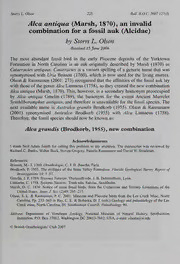
Alca antiqua (Marsh, 1870), an invalid combination for a fossil auk (Alcidae) PDF
Preview Alca antiqua (Marsh, 1870), an invalid combination for a fossil auk (Alcidae)
StorrsL. Olson 225 Bull. B.O.C. 2007127(3) Alca antiqua (Marsh, 1870), an invalid combination for a fossil auk (Alcidae) by Storrs L. Olson Received 15June 2006 The most abundant fossil bird in the early Pliocene deposits of the Yorktown Formation in North Carolina is an auk originally described by Marsh (1870) as Catarractes antiquus. Catarractes is a variant spelling ofa generic name that was synonymised with JJria Brisson (1760), which is now used for the living murres. Olson & Rasmussen (2001: 273) recognised that the affinities ofthe fossil auk lay with those ofthe genusAlca Linnaeus (1758), so they created the new combination Alca antiqua (Marsh, 1870). This, however, is a secondary homonym preoccupied by Alca antiqua Gmelin (1789), the basionym for the extant Ancient Murrelet Synthliboramphus antiquus, and therefore is unavailable for the fossil species. The next available name is Australca grandis Brodkorb (1955). Olson & Rasmussen (2001) synonymised Australca Brodkorb (1955) with Alca Linnaeus (1758). Therefore, the fossil species should now be known as: Alca grandis (Brodkorb, 1955), new combination Acknowledgements I thank Neil Adam Smith for calling this problem to my attention. The manuscript was reviewed by RichardC. Banks,WalterBock, StevenGregory,PamelaRasmussenandDavidW. Steadman. References: Brisson,M.-J. 1760. Ornithologie. C. J. B. Bauche,Paris. Brodkorb, P. 1955. The avifauna ofthe Bone Valley Formation. Florida GeologicalSurveyReport of Investigations 14: 1-57. Gmelin,J. F. 1789. SystemaNaturae. Thirteenthedn. J. B. Delamolliere, Lyon. Linnaeus, C. 1758.SystemaNaturae.Tenthedn. Salvius, Stockholm. Marsh, O. C. 1870. Notice ofsome fossil birds, from the Cretaceous and Tertiary formations ofthe UnitedStates.Amer. J. Sci. (2)49: 205-217. Olson, S. L. & Rasmussen, P. C. 2001. Miocene and Pliocene birds from the Lee Creek Mine, North Carolina. Pp. 233-365 in Ray, C. E. & Bohaska, D. J. (eds.) Geology andpaleontologyofthe Lee Creekmine,NorthCarolina,III.Smithsonian Contrib. Paleobiology90. Address: Department of Vertebrate Zoology, National Museum of Natural History, Smithsonian Institution,P.O. Box37012,WashingtonDC20013-7012,USA,e-mail: [email protected] ©BritishOrnithologists'Club2007
